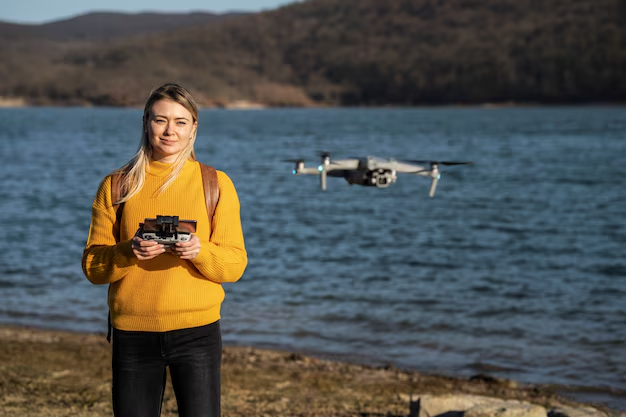Thermographic camera drones are revolutionizing the way we capture and analyze heat signatures from above. Equipped with infrared sensors, these drones can detect temperature variations that are invisible to the naked eye, making them invaluable tools in various industries. From inspecting solar panels and power lines to assisting in search and rescue missions and monitoring wildlife, thermographic drones provide critical data with unmatched accuracy and efficiency. In this guide, we’ll explore the features, applications, and benefits of thermographic camera drones, helping you understand why they are becoming essential tools for professionals worldwide.
1. DJI Matrice 300 RTK (with FLIR Zenmuse H20T)
- Camera: Dual payload with RGB + thermal (FLIR Zenmuse H20T).
- Flight Time: 55 minutes.
- Range: 15 km.
- Use: Industrial inspections, surveying, emergency response.
Pros:
- Dual camera system for both thermal and visual imaging.
- Excellent endurance and range.
- RTK positioning for precision.
Cons:
- Expensive and requires professional skills.
- Bulky design.
Purchase: DJI Matrice 300 RTK
2. Parrot Anafi USA

image credit by Parrot Anafi USA Official
- Camera: 4K HDR + FLIR thermal camera.
- Flight Time: 32 minutes.
- Range: 4 km.
- Use: Search and rescue, law enforcement, industrial inspections.
Pros:
- Compact and lightweight, easy to transport.
- Dual cameras for versatile imaging.
- User-friendly interface for quick deployment.
Cons:
- Shorter flight time and range.
- Higher price point for general consumers.
Purchase: Parrot Anafi USA
3. Sense Fly eBee X

image credit by Sense Fly eBee X Official
- Camera: Options for RGB, thermal, and multispectral cameras.
- Flight Time: 90 minutes.
- Range: 120 km.
- Use: Agriculture, surveying, large-scale mapping.
Pros:
- Extremely long flight time and range.
- High-precision RTK/PPK technology for accuracy.
- Great for large area inspections.
Cons:
- Expensive, designed for professionals.
- Requires technical expertise for operation.
Purchase: senseFly eBee X
4. DJI Mavic 2 Enterprise Dual
- Camera: 4K camera + FLIR thermal camera.
- Flight Time: 31 minutes.
- Range: 8 km.
- Use: Search and rescue, inspections, law enforcement.
Pros:
- Compact and foldable for portability.
- Dual cameras for both thermal and optical use.
- Built-in speaker and spotlight for emergency situations.
Cons:
- Limited range and battery life.
- Not as powerful as industrial-grade drones.
Purchase: DJI Mavic 2 Enterprise Dual
5. Yuneec H520E RTK

image credit by Yuneec H520E RTK Official
- Camera: E50 (RGB) + E90 (thermal camera).
- Flight Time: 28 minutes.
- Range: 1.6 km.
- Use: Public safety, industrial inspections, surveying.
Pros:
- RTK for accurate georeferencing.
- Multiple camera options including thermal.
- High-quality gimbal for stability.
Cons:
- Shorter flight time and range compared to competitors.
- Price may be a barrier for casual users.
Purchase: Yuneec H520E RTK
6. DJI Matrice 210 RTK
- Camera: Compatible with Zenmuse XT2 thermal camera (dual sensor).
- Flight Time: 38 minutes.
- Range: 7 km.
- Use: Industrial inspections, fire and rescue, surveying.
Pros:
- RTK for precise data collection.
- Dual payloads for flexible use cases.
- Advanced safety features for stable flight.
Cons:
- Expensive setup for most consumers.
- Large and heavy for portability.
Purchase: DJI Matrice 210 RTK
7. Quantum Systems Trinity F90+

image credit by Quantum Systems Trinity F90+ Official
- Camera: Thermal, RGB, and multispectral camera options.
- Flight Time: 90 minutes.
- Range: 100 km.
- Use: Large-area surveying, industrial inspections.
Pros:
- High endurance with 90-minute flight time.
- Large operational range and coverage.
- Multispectral and thermal options for diverse applications.
Cons:
- High cost, targeting professional users.
- Requires expertise to operate.
Purchase: Quantum Systems Trinity F90+
8. FLIR SkyRanger R70

image credit by FLIR SkyRanger R70 Official
- Camera: FLIR thermal and optical cameras.
- Flight Time: 50 minutes.
- Range: 15 km.
- Use: Public safety, search and rescue, defense.
Pros:
- High-quality thermal and visual cameras.
- High endurance for long-term operations.
- Tough build for harsh environments.
Cons:
- Expensive for non-industrial use.
- Requires trained operators.
Purchase: FLIR SkyRanger R70
9. Autel Robotics EVO II Dual
- Camera: 8K camera + FLIR thermal camera.
- Flight Time: 40 minutes.
- Range: 9 km.
- Use: Law enforcement, emergency services, industrial inspection.
Pros:
- Dual cameras for high-quality imagery.
- Foldable design for easy transport.
- Advanced safety features and obstacle avoidance.
Cons:
- Price may be too high for casual users.
- Limited payload options.
Purchase: Autel Robotics EVO II Dual
10. Griffin 500
- Camera: Thermal camera for industrial inspection.
- Flight Time: 35 minutes.
- Range: 6 km.
- Use: Energy sector inspections, building diagnostics.
Pros:
- High-quality thermal imaging.
- Long flight time for larger areas.
- Compatible with multiple camera sensors.
Cons:
- Not as portable as other options.
- Expensive for basic users.
Purchase: Griffin 500
Conclusion:
In conclusion, thermographic camera drones have transformed the way we observe and analyze heat patterns, offering unparalleled accuracy and versatility across various industries. From enhancing safety in industrial inspections to aiding in search and rescue missions, these drones provide valuable thermal data that is otherwise difficult to obtain. As technology advances, thermographic drones are becoming more accessible and sophisticated, empowering professionals to work more efficiently and safely. Whether you’re in construction, agriculture, public safety, or environmental monitoring, investing in a thermographic camera drone can significantly enhance your operational capabilities and decision-making processes.



